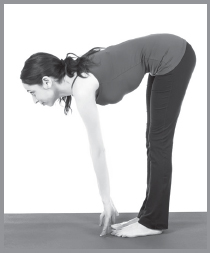
Half Forward Fold
It is Sunday, and it’s warm and sunny with a light breeze outside. My 14- year-old is moody, and I decide to give her some time to herself. After lunch, she wants to take the dogs for a walk and I agree. We pack a snack, water, dog treats and get the dogs in the car. We talk very little in the car today, and I’m looking forward to the physical exercise that will be great for both our spirits. I’m thrilled that she wants to get out in nature. I am glad I have given her enough positive nature experiences while growing up that she is choosing this to make herself feel good.
The dogs jump out and we start the steady climb up the 20-minute walk to the top of the pond. The wind is refreshing, and sun is warm on my face. The gurgling of a mountain stream catches my attention, my most favorite nature sound. The sound of the water skipping over the rocks fills my ears and blocks out all the other sound. Focused on the present moment, I revel in that awareness of just being happy. I am fully in all of my senses. The sunlight and the foliage draw me in as I take in the beauty of the woods. I find myself gliding out of my normal worry and stress. I am repeating the So-Ham mantra while I breathe and walk with my daughter. We are walking in silence and contented.
I would often suggest the hike if my daughter seemed moody and not interested in talking. Just walking silently was bonding and nourishing. I felt I could almost see the fuzzy confusing entangled mental activity of her adolescent mind silently being erased by nature. All I had to do was walk silently. Sometimes I would watch my breath and repeat a mantra while next to her quietly in between some quiet talk. Both of us would return in a better mood. As she became older, she would seek the silent solace of nature herself, jogging when she felt the need to sort out her feelings.
• Walk alongside the teen and remain silent.
• Watch your own breath and focus on the inhale and exhale.
• Use a mantra “So-Ham” or a positive intention thought such as, “I am one with everything in the universe.” Then inhale on Ham and exhale on the So. Say silently one syllable on the inhale and then the next on the exhale. (Some yoga teachers teach inhale on So and exhale on Ham.)
• You can use any positive intention thought.
• It isn’t necessary to invite the teen to do this. If you are breathing in this way, you will bring a peaceful feeling to the walk together that is non-judgmental, accepting and still.
• Just be with the teen in a “non-striving” mode.
• Reflect on the mindfulness qualities of non-judgment, and acceptance.
• It isn’t necessary to discuss with the teen what you are doing.
• The teen might want to know why you seem so happy. You can share about walking with the breath and mantra.
• Forcing a teen to do this activity won’t be effective.
• When you are breathing and doing the mantra silently, you offer powerful support to the other people around you with your calm state.
Late for work on a busy Friday morning, I was standing in line for a muffin at the gas station. Suddenly realizing how many people were in front of me, I became anxious. I took a deep breath, unconsciously, and the mantra spontaneously began inside me. This calmed me down and gave me a focus.
A mantra can be any positive thought and from any background of your preference. When I pause and say a mantra, it is a conscious choice I use. The technique of saying a mantra quickly alerts me to shift focus to the breath and the intention of the statement. Within seconds I plummet into the powerful experience of deep breathing. I am repeating “So” on the inhale and “Ham” on the exhale. “So Ham,” means, “I am that” or “I am in relationship to the universal self, my deepest truth, or my own rhythm.” This helps me to connect to something greater than my small self or ego.
Through the ages mantras from ancient traditions have been used for protection, connecting to our highest spirit, for removing obstacles and for experiencing peace within us. We can also utilize the quality of “intention” to create a more personal mantra. An intention is a statement that is in the present tense and the action of the statement is considered already attained. “I flow with change.”
A mantra can be a universal thought such as, “I am one with the source of all things.” At times you might need one mantra for a situation and a few months later need another. “I am love” may work for you at one time and then during a difficult life change “I flow with change” might be a right fit for another time. For young children or adolescents simple statements such as, “I love myself,” “I am happy with myself,” “I can do this,” “The sun shines on me,” “I accept myself”or “I am pure awareness “are statements anyone can relate to.
Write a Mantra That Fits for You.
The purpose of creating a personal mantra and an intention statement is to have thoughts that we can resonate positively with. Use these tips to get started.
Start with a pronoun or noun_______________ (I, We, My Heart, the Sun)
Add a verb__________________________________ (love, accept, am, feel)
Complete the statement with a noun_____________ and add an adverb__________ or an adjective or description.
I love and accept myself the way I am.
I remain calm in the face of adversity.
I accept change easily.
Everything happens for the best.
I honor the light within us all.
The sun always shines on me.
• Give examples of a mantra to choose from.
• Share the explanation from above paragraphs.
• Begin with Pranayama (equal breath, Ujjayi or three- part breath).
• Explain the three-step process and the quality of intention.
• Allow students to create their own mantra and write it on a card.
• Decorate the card and have the student make it personal.
• Practice the mantra silently with the breath for a few minutes.
• Add a hand mudra if you wish when practicing for focusing.
• Sit in an upright posture with your back straight.
• Repeat the mantra as you can, when in need and as a focus tool.
Walking with the dog, dressed casually without makeup, I pass a store and catch a glimpse of myself in the mirror. I’m not thrilled with what I see and tell myself that I look tired and washed out. I start identifying with thoughts, “I’m old, and I’m unattractive.” In that moment, I’m beginning to feel bad about myself.
Yoga psychology is based on the ancient scriptures of Patanjali and his directives on how to still the mind. When the ego is at work, it is weaving a veil over our consciousness; deluding us into thinking we are nothing more than this physical body, these thoughts or feelings, or this circumstance. We easily buy into the ego’s work. We lose touch with our true identity, the pure awareness or universal consciousness, a place of love and acceptance within us.
Our small self or ego is the part that is always thinking limiting thoughts such as “I’m not good enough, I’m not smart, and I’m too fat or tall” or the opposite thoughts such as: “I’m the smartest” or “I’m the best athlete.” All day these types of thoughts loop through the mind. A positive aspect of our ego can give us strength, a personality, even confidence. I’m referring to the part of the ego that links us to limiting beliefs. We have been exploring how breathing technique, somatic exercises and yoga can help us reconnect to ourselves and combining this with a positive thought.
The challenge of reconnecting to ourselves begins with a process called identification. We lose our power as we identify our worth with limiting thoughts, “I’m not good enough,” “I’m not smart” instead of just noticing the thought passing in the mind. Identification with the limited belief elevates it to become a gatekeeper to our state of happiness. The gatekeeper holds the door closed to an experience of the universal self. The more we entrain ourselves to the limited thoughts, the mind becomes like a path being carved out as we repeatedly tromp down the grass walking along the same spot. It is as if the mind unconsciously will slide over to the groove of the limited belief that we created, instead of trying new ways of thinking.
In this activity, we notice how we feel in our body when we think limiting thoughts or expansive thoughts. You can make a stick figure drawing with two or three cartoon bubbles for the character’s thoughts coming out of his head.
• On a piece of paper individually, or the white board in a group, make two columns.
• On the left side, write limiting thoughts.
• Make a list of thoughts the small self or ego likes to tell you such as “I’m not smart, I’m worthless, and I’m a failure.”
• Try to notice how you feel in your body; notice your posture when you think these thoughts.
• On the right column change your thought to a positive one such as
“I am connected to love and it exists inside of me.”
“Unconditional love dwells within me.”
“I am linked to the universal love in my heart.”
• Assume the Mountain pose. Take three inhales and exhale.
• Assume the Warrior 2.
• Do the Ha breath orchestra
• Do the grounding column, and send the negative small self thoughts down into the earth. Pull up the positive ones from below and mix them together to create a positive experience.
• Notice how your body and mind changes with a positive thought combined with breathing and yoga.
• Create a very safe space and use humor.
• Give personal examples and stories to warm up the group.
• Adolescents might feel embarrassment and prefer to do this individually. You don’t want a student to be vulnerable and reveal a limited thought and then be bullied or made fun of by others.
• Preschool children can relate the meaning of the limited belief with pictures of different size animals. The animals may think, “I’m too big” or “I’m too small, “I’m too smart” or “I’m not smart enough.”
• School age children can relate to a story about a character that demonstrates a limited belief and overcomes the belief by accessing his inner strength.
Half forward fold
Uttanasana
Beginning of side stretch
Intense side stretch (Parsvottanasana)
Forward Bend with Chair
Find ways to interject yoga breaks in transition between subjects. Remind the students to use their personal mantra for focusing or on one the teacher has chosen that fits the moment. Do a sequence: Warrior 2, Triangle, Parsvottanasana (side stretch)
• Practice silent walking for several minutes in the room.
• Do a short Vinyasa of Warrior 1,2, Happy Warrior
• Do the equal breath.
• Standing half-forward fold while sounding out the OH sound
• Practice Uttanasana or full fold
• Chair forward bend.
• Standing backbend with hands on the desk behind you.
• Cat and Cow in stand at the desk, with arms behind head.
• Do Golden Ray meditation.
• Do Gentle Breeze meditation.
• Do raft guided imagery.
• Sitting in the Chair: Begin to breathe in the three-part breath. Reaching both arms overhead take an inhale. Take an exhale as you move the arms down again. Repeat this five times.
• Seated Cat and Cow: Placing your hands behind your head and interlaced, do the Cat folding forward, bringing elbows together with an exhale. Then open the folded arms, bringing the arms back with a slightly arched back while inhaling. Repeat five sets
• Side bends: Inhale and raise the left arm. Lean to the right, with arm overhead. Exhale and bring the arm back to the center. Repeat with the right arm over the head, bending to the left side and then back to center.
• Seated twist: Find a comfortable seated posture facing forward. Turning to the right, bring the right arm behind you and hold the chair back. Continue rotating with the left hand, twisting the torso, and place the left hand on the outside of the right leg.

Half Forward Fold
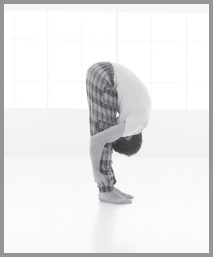
Uttanasana
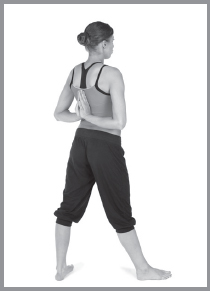
Beginning of Side Stretch
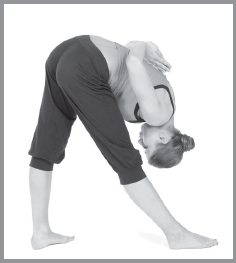
Intense Side Stretch (Parsvottanasana)
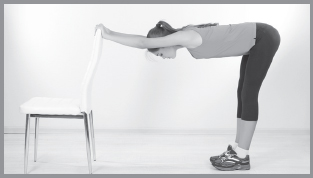
Forward Bend with Chair
A personal mantra is using the power of a grouping of words with the breath. The mantra has the intention to uplift us and bring us to a still, calm place within us. We take the words into our awareness on a cellular level of the body, by layering through our body systems into the tissues. Children and adolescents who have been exposed to trauma hold this trauma in the tissues of their body. When we repeat the mantra, combine the deep breathing, and posture, the positive thought construct of the mantra could be absorbed into the tissues of our body. The mantra repetition, Pranayama and poses become an embodying experience for the student.
There are many ways to have an experience of our own true nature. We can gently open the door to our deepest truth with nature, mantra, breath, contemplation, prayer, the arts and doing physical postures. Sometimes it feels as though we have to pry the door open because we are identifying so much with the limited beliefs. We may block an experience because the mind is so busy chattering. But as we get more comfortable tuning into the breath, the mind is coaxed more easily and quickly into a peaceful calm place. Once you are noticing the breath, the calming nature of the parasympathetic nervous system helps you to feel more relaxed. This is a powerful tool for a young person to have access to.
The ego is the aspect of our mind that keeps us disconnected from our deepest self. The deeper self, immune to mental chatter, physical pain or emotions, is a place of unconditional love that is in all of us. Unfortunately, our busy minds can block accessing that universal place. Meditation, mantra and breathing can be a tool. As we use a breathing technique and take the assistance of a mantra, we become less attached to the mind, emotions and body and go to a quieter place within that is in the present moment, and universally peaceful. We connect more seamlessly to ourselves and feel more whole and at peace. We can manage conflicts, stress and challenges more effectively.
When I use a mantra (or a thought with a high intention), it fills me with positive feelings. I find it helps relationships with others, because it allows me to tune in to myself, be non-judgmental, love myself, keep healthy boundaries and be more joyful. It helps me by providing a wedge between the constant chatter of my mind and its loop of worrying thoughts and to do lists. Repeating a mantra keeps me in touch with my heart or my feelings.